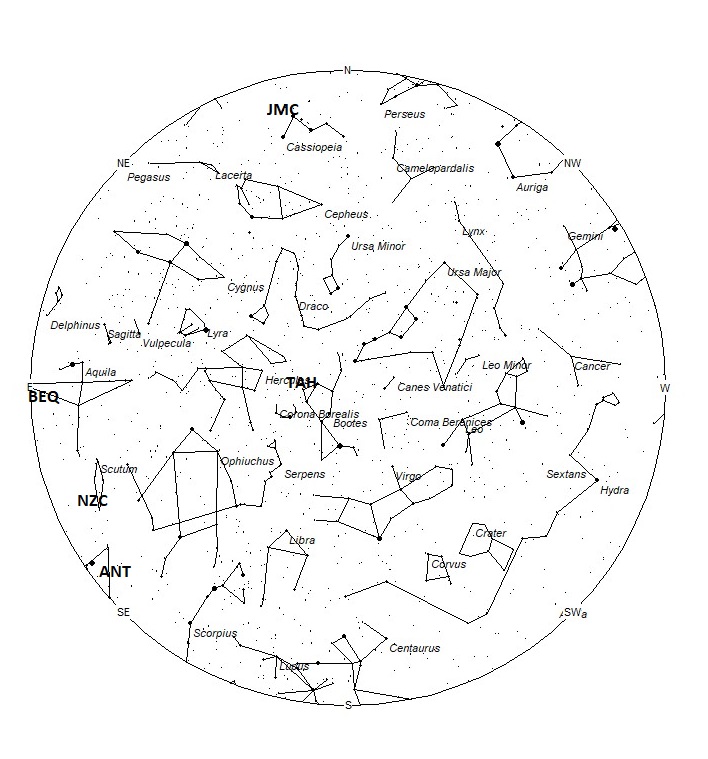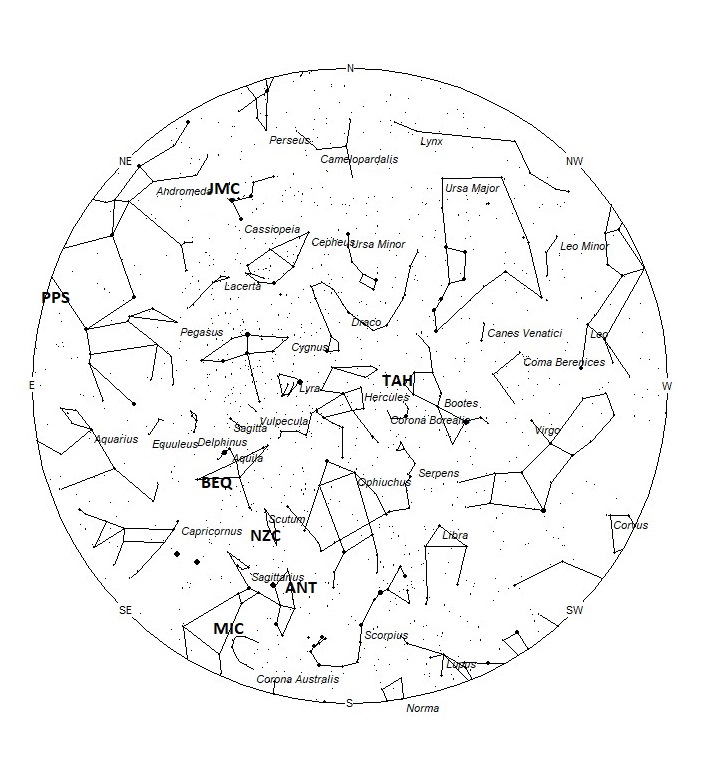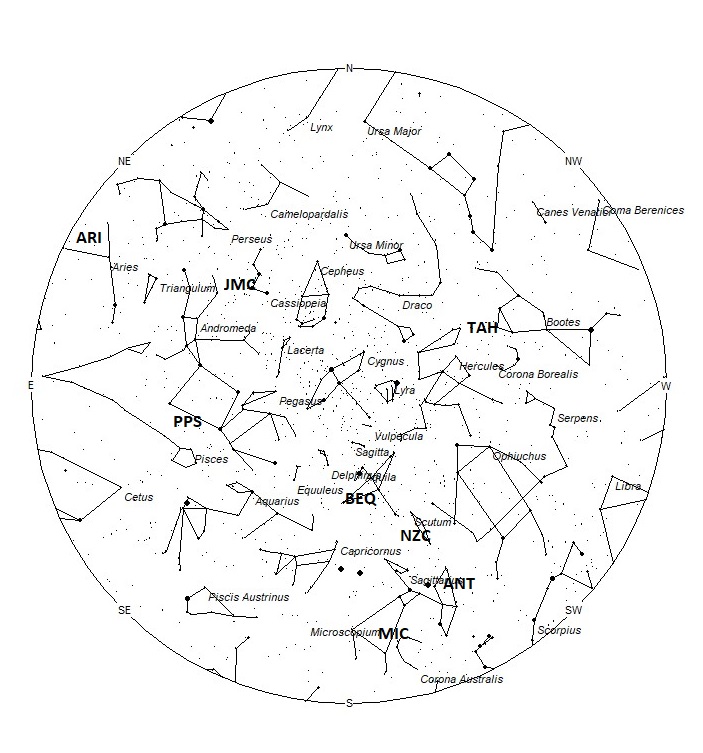
320 exposures – 30 sec, 2.8 F, 320 ISO
During this period the moon’s phase wanes from full to nearly half illuminated. As the week progresses the waning gibbous moon will rise later each night, providing a small window of dark skies between dusk and moonrise. Unfortunately, meteor activity during this time of night is low, but this is offset by the opportunity for younger observers to view the dark evening sky prior to bedtime. The estimated total hourly meteor rates for evening observers this week is near 2 for those viewing from the northern hemisphere and 3 for those located south of the equator. For morning observers the estimated total hourly rates should be near 4 as seen from mid-northern latitudes (45N) and 7 as seen from tropical southern locations (25S). The actual rates will also depend on factors such as personal light and motion perception, local weather conditions, alertness and experience in watching meteor activity. Rates are reduced by moonlight during this period. Note that the hourly rates listed below are estimates as viewed from dark sky sites away from urban light sources. Observers viewing from urban areas will see less activity as only the brightest meteors will be visible from such locations.
The radiant (the area of the sky where meteors appear to shoot from) positions and rates listed below are exact for Saturday night/Sunday morning June 6/7. These positions do not change greatly day to day so the listed coordinates may be used during this entire period. Most star atlases (available at science stores and planetariums) will provide maps with grid lines of the celestial coordinates so that you may find out exactly where these positions are located in the sky. A planisphere or computer planetarium program is also useful in showing the sky at any time of night on any date of the year. Activity from each radiant is best seen when it is positioned highest in the sky, either due north or south along the meridian, depending on your latitude. It must be remembered that meteor activity is rarely seen at the radiant position. Rather they shoot outwards from the radiant so it is best to center your field of view so that the radiant lies at the edge and not the center. Viewing there will allow you to easily trace the path of each meteor back to the radiant (if it is a shower member) or in another direction if it is a sporadic. Meteor activity is not seen from radiants that are located below the horizon. The positions below are listed in a west to east manner in order of right ascension (celestial longitude). The positions listed first are located further west therefore are accessible earlier in the night while those listed further down the list rise later in the night.
These sources of meteoric activity are expected to be active this week.
Detailed descriptions of each source will continue next week when viewing conditions are improved.
| SHOWER | DATE OF MAXIMUM ACTIVITY | CELESTIAL POSITION | ENTRY VELOCITY | CULMINATION | HOURLY RATE | CLASS |
| RA (RA in Deg.) DEC | Km/Sec | Local Daylight Saving Time | North-South | |||
| tau Herculids (TAH) | Jun 02 | 15:28 (232) +39 | 15 | 00:00 | <1 – <1 | III |
| Anthelion (ANT) | – | 17:56 (269) -23 | 30 | 02:00 | 1 – 2 | II |
| Northern June Aquilids (NZC) | Jul 02 | 19:00 (285) -12 | 41 | 03:00 | <1 – <1 | IV |
| Microscopiids (MIC) | Jul 05 | 19:16 (289) -36 | 39 | 04:00 | <1 – <1 | IV |
| beta Equulids (BEQ) | Jun 14 | 19:35 (295) -02 | 33 | 04:00 | <1 – <1 | IV |
| phi Piscids (PPS) | Jul 04 | 23:35 (354) +14 | 67 | 08:00 | <1 – <1 | IV |
| June mu Cassiopeiids (JMC) | Jun 08 | 00:58 (015) +55 | 42 | 09:00 | <1 – <1 | IV |
| Daytime Arietids (ARI) | Jun 07 | 02:56 (044) +24 | 41 | 11:00 | <1 – <1 | I |
 American Meteor Society
American Meteor Society



Saw what looked like a huge comet across sky above JPL LaCanada CA. Moving from North to South.
White with colored outer boarder . Long curved white tail.
Been lucky in finding Meteors. Have a nice collection. Always enjoy watching the skies and hunting. Open fields and yes even creeks are your best bet in finding them.
May have been a fireball streaking through the sky as I looked west from Chapman courte, east of JPL
Saw a huge flash of white light move across the sky and disappear today around 8:50 pm
I saw the same last night!
Tonight I saw a small green fireball with tail flying above and over my car while driving. It than blew up and sparks were flying with sparking dust quickly disappeared. So amazing !!!
This comment was posted on my Facebook at about 8:53 pm tonight (6/10/20) “I just saw the biggest meteor go over my head!! Huge! Never ever in my life had I seen the sight of a huge blazing meteor EVER!!!! ❤️
Sawittre Sinsaeng
Auburn CA
Saw bright light going from s.w to n.e direction, eastlake ohio. I’m pretty sure. It was unexpected. I happened to be looking out the window when I saw it at 3a.m. 20 sec later saw another light going in opposite direction.
I saw one coming out of Grass Valley tonight around 8:20-8:30. It was cool
Saw a bright blue flash across the sky at 4:30 am this morning, June 12, 2020. Was startled as my curtains were mostly closed but another person confirmed that there was a flash across the sky. Was that a meteor ? Hope so. Was impressive. On the northeastern coast of Jamaica.